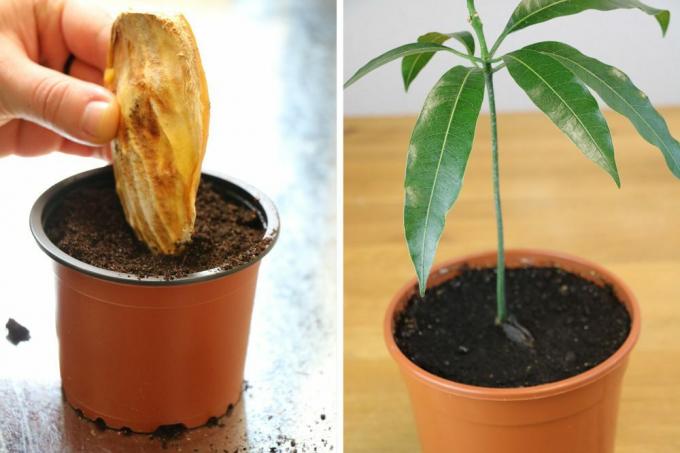
table of contents
- Characteristics
- Not every mango is suitable for growing
- Location
- floor
- Plant the mango tree
- Plant mango kernels
- care
- to water
- Fertilize
- Cut
- Overwinter
- Repot
- Multiplication
- Diseases
- Pests
Profile and care information open +conclude -
- Flower color
- multicolored
- Location
- Partial shade, sunny
- Heyday
- June July August
- Growth habit
- upright, expansive
- height
- up to 4 meters high (in the bucket)
- Soil type
- loamy
- Soil moisture
- moderately moist, fresh
- PH value
- neutral, slightly acidic
- Limescale tolerance
- Calcium intolerant
- humus
- rich in humus
- Poisonous
- Yes
- Plant families
- Sumac family, Anacardiaceae
- Plant species
- Container plants, fruit trees, ornamental trees
- Garden style
- Winter garden
In Germany the mango tree is kept almost exclusively as a container plant because it is not winter hardy. It rarely bears flowers and fruits in this country, if at all. He feels most comfortable in heated greenhouses and winter gardens. With a little patience and the right care, a beautiful little tree can be grown from the core of a suitable fruit. This is a bit of a hassle but well worth the effort.
Characteristics
- Plant family: Sumac family (Anacardiaceae)
- Genus: Mangoes (Mangifera)
- Origin: India, tropical rainforest
- Botanical name: Mangifera indica
- Growth: evergreen, fast-growing, spreading, rounded crown
- Height: 180 to 400 cm
- Blossom: rare, after 10 years at the earliest, multicolored, fragrant
- Flowering time: summer
- Leaf: dark green, leathery and shiny
- Lime tolerance: incompatible with lime
Not every mango is suitable for growing
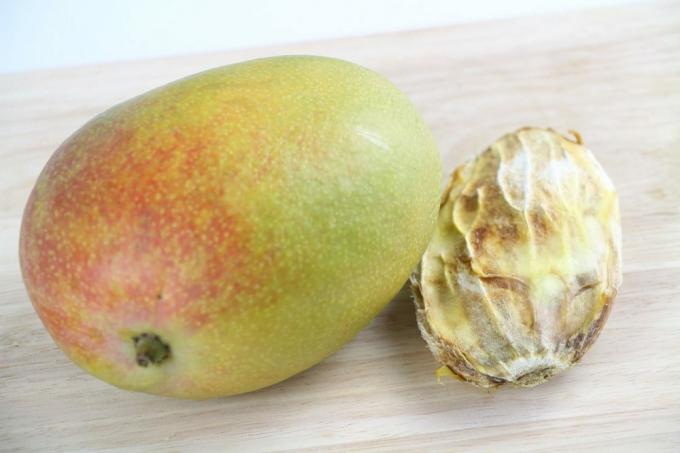
Pre-grown mango trees are hard to come by in normal gardening shops. Therefore, they are usually made from their seeds or pulled the kernels. But not every core is suitable. This applies in particular to kernels from fruits from the supermarket or discount store, which it is better not to use for self-cultivation.
This is because these fruits have very often been treated with germ-inhibiting substances. They have traveled long distances, were harvested and refrigerated very early. As a result, the kernels could not develop optimally and are severely restricted in their ability to germinate.
It looks better with mangoes from the health food store, they are untreated. Or you can look around for suitable seeds in special internet shops. Since mangoes in Germany can only be kept in buckets, it is best to keep varieties that remain small, such as. B. Use 'Cogshall' and 'Carrie', which are usually the easiest to come by.
Location
- sunny, warm, evenly humid and sheltered from the wind
- blazing sun no problem for older mango plants
- young mango trees a little more sensitive
- get used to the sun initially
- put it in a partially shaded place for a few days
- later, preferably all year round, in a heated glass house or winter garden
- In addition to heat, mango requires a lot of light and high humidity
- During the summer, it can also be used outdoors
- from temperatures below 15 degrees, staying outdoors is problematic
floor
The substrate for a young mango plant should be slightly acidic and permeable. Larger specimens also do very well in slightly loamy soil. The mango tree doesn't like lime at all. Sandy soils are also completely unsuitable. On the other hand, a mixture of normal garden soil, compost and coconut fiber, roughly in equal parts, is ideal. Alternatively, you can also use high-quality potted plant soil from specialist gardeners.
Plant the mango tree
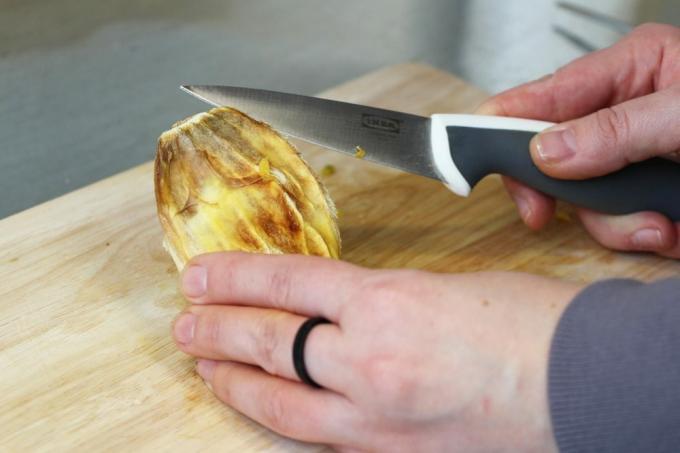
Seed production
If you want to plant a mango tree, it's actually about planting the core of a mango. Only fully ripe fruits should be used to obtain seeds. The ripeness of a mango can be recognized, for example, by a slightly leathery outer skin that gives way when little pressure is applied.
The color is not a meaningful indicator of the ripeness of a fruit. This can be different depending on the origin. While ripe Indian mangoes are intensely yellow, in places also light red, Brazilian mangoes are far from ripe even when they are deep red. And Filipino mangoes are still green even when fully ripe.
Expose actual seeds
If you want to grow a mango plant from a ripe fruit, you first have to get to the core and prepare it accordingly. It is best to wear gloves because mango kernels contain substances that can irritate the skin of sensitive people.
- Remove the core from the pulp with a knife
- then let the mango kernel dry for a while
- shouldn't be slippery now
- now break open with a sharp knife and expose the seeds
- Seed resembles a large, flat bean
- can be brown, light green or whitish green
- gray, wrinkled core no longer germinable
You can also plant the mango kernel together with the white shell as soon as it has been freed from the pulp and has dried a little. With a germination time between one week and three months, this method is much longer than with seeds that are planted without a cover. Here it usually takes one to two weeks for germination.
Tip: To open the core, carefully prick the tip with a sharp knife, guide it along the side and pry it open. Then it should be possible to open the outer cover without any problems.
Prepare seeds
If the actual seed of the mango is exposed, it must also be subjected to further treatment in order to be able to germinate safely. There are two different methods for doing this, one is drying and the other is soaking.
1. dry
The seed must be completely dry. The best way to do this is to put it in a warm, sunny and draft-free place, for example on the window sill. It remains there for about three weeks. After this time, you press it open a little without breaking it, otherwise it would probably no longer germinate. The seed prepared in this way is left to rest for another week before it can be planted.
2. soaking
With this variant, the seed is carefully scratched in one place and placed in a glass of room temperature water for 24 hours. Then you wrap it in a damp kitchen towel or paper handkerchief and put it in a freezer bag. This is then fixed or fixed with a clip. hermetically sealed. Now put the whole thing in a warm place for about two weeks. During this time, the seed usually develops roots and a seedling. If the seeds are prepared accordingly, the soil is on.
Make the growing medium sterile
The substrate, especially commercially available growing media, also requires a certain amount of preparation. In order to grow a mango tree and to protect the young seedlings from soil pests and fungal pathogens, it is advisable to make the soil aseptic. Otherwise it should be low in nutrients and loose with a pH value not above seven. In addition to special cultivation soil, coconut substrates from specialist gardeners are also suitable.
In order to achieve sterility, the substrate is placed on a suitable surface and then placed in the oven for a quarter of an hour at about 160 degrees. Or you can put them in the microwave on a high setting for a short time. Make sure that the soil is slightly damp and not covered so that the moisture can escape. In the oven, you clamp a wooden spoon or something similar in the oven door so that it stays ajar. This is not necessary with the coconut substrate.
Plant mango kernels

Small pots are not suitable for planting a mango. They should have a diameter of at least 40 cm and, above all, be deep, as the mango forms deep tap roots.
Several drainage holes in the bottom of the pot are indispensable in order to avoid waterlogging.
- Fill the planter with a little ripe compost and a mixture of soil and sand
- alternatively, use commercially available potted plant soil
- Plant seeds with sprout upright
- so deep that the germ looks two to three centimeters out of the earth
- then water with lukewarm water, ideally using a spray bottle
- Spray mist prevents soil from being washed away
- Keep the substrate evenly moist for the next few weeks
- Avoid waterlogging at all costs
- Pay attention to high humidity and constant temperatures of 25 to 30 degrees
- after four to six weeks, the seedling grows
- if the pot is well rooted, transplant
Seedlings that have already loosened from the seed are carefully planted about 20 cm deep with the root down. Only a few leaves should stick out of the earth. They grow into small trees faster than a planted core with a germ. Of course, this requires proper care.
care
to water
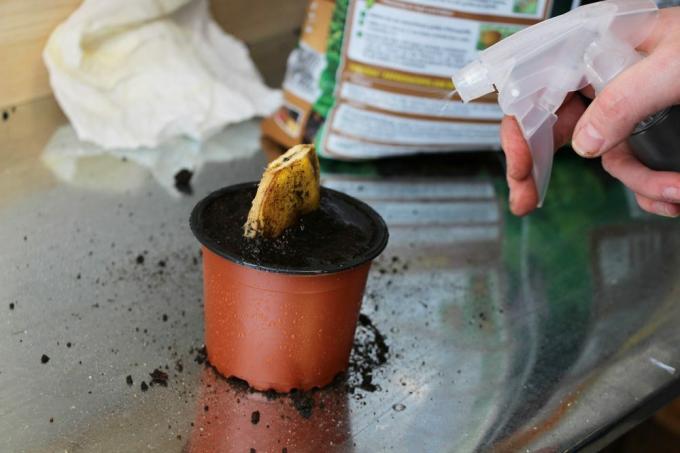
In order for the tree to grow and thrive, it must be cared for accordingly. An important part of maintenance is watering. A mango tree loves evenly moist soil and high humidity. However, they must not be too wet, otherwise the roots could rot quickly. To avoid waterlogging, it is essential to ensure good water drainage. In order to ensure a correspondingly high level of humidity, the mango plant is sprayed with water every day if possible.
Both the irrigation water and the water for spraying should be lukewarm and, above all, soft or soft. Low in lime, ideally free of lime. When choosing the right planter, clay is more advisable than plastic. Clay has the property of absorbing excess water and releasing it into the air.
Tip: If only tap water is available, it must be stale for at least a week before it can be used for watering. This allows the lime to settle on the ground.
Fertilize
Seedlings draw their nutrients from the core and therefore do not need additional fertilization. Only about two months do you start fertilizing. Apply a low-dose liquid fertilizer once a week from April to September. You should use about a quarter of the usual amount recommended by the manufacturer.
Cut
As a rule, a mango tree does not need regular pruning. However, you can stimulate a younger mango plant to branch better by pruning. Dead plant parts and individual shoots that are too long can also be cut out without problems. The ideal time for these measures is in winter.
Overwinter
As already mentioned, the mango tree (Mangifera indica), which comes from the tropics, is not winter hardy in Germany. As a result, it has to overwinter frost-free and light at temperatures around 15 ° C (+/- 5). A short-term minimum temperature of 3 ° C is tolerated by both young plants and older specimens.
Young plants should be kept warm at the beginning, older plants also get along very well in cool winter temperatures. The warmer the quarter, the lighter the plant has to be. Care should not be neglected in winter either. If the winter is warm, watering and fertilization must continue. Not to forget the regular spraying of the mango plant. When the winter is cool, the need for water and fertilizer is correspondingly lower.
Repot
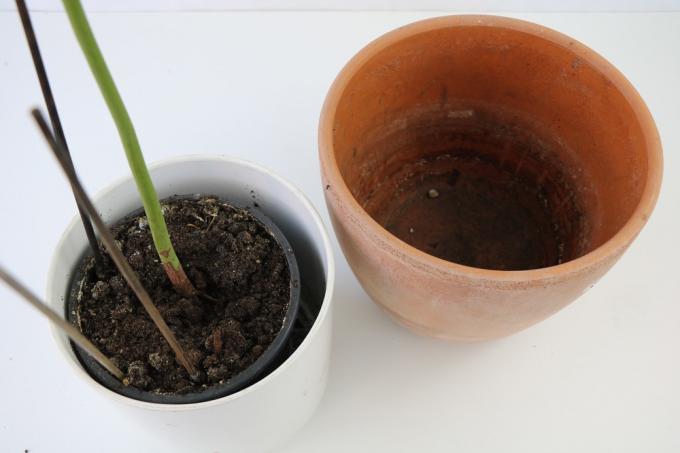
Another part of maintenance is repotting. A mango tree grows quickly and its planter is often rooted within one season. As a result, he needs a larger pot and fresh soil.
- repot for the first time after two years at the earliest
- later at regular intervals of one to two years
- best time in spring, after overwintering.
- new planter only slightly larger than the old one
- deeper rather than wider because of the tap roots
- Put gravel drainage on the bottom of the pot
- If necessary, cover the drainage with fleece
- then fill in part of the substrate
- Now carefully lift the plant out of the old pot
- Avoid damaging the roots if possible
- Remove loose soil adhering to the roots
- Put the mango back in the middle
- Plant as deep as in the old pot
- Fill up to a few centimeters below the edge of the pot with soil
- Press the soil on and water
Tip: After transplanting, it is advisable to place the plant on a roller coaster, because it can grow relatively quickly and consequently also gain weight.
Multiplication
Anyone who already owns a mango tree can grow other plants from cuttings. To do this, cut off fresh, green, 15-20 cm long shoots and remove the lower leaves. Then you put them directly into small pots filled with potting soil. That should have a temperature between 22 and 30 degrees. After the cuttings have been inserted, the substrate is moistened and kept evenly moist until the roots form. About the pot or A translucent plastic bag is placed over the cuttings and removed briefly every day for ventilation. If the first new shoot appears on the cuttings, the film can be removed.
Diseases

In its country of origin, the mango tree is susceptible to diseases such as anthracnose (focal spot disease) or verticillium wilt due to the climate. The latter occurs outdoors, for example when the tree is planted where previously vegetables such as. B. Tomatoes were grown. Since the mango tree is not planted outdoors in our latitudes, there is no danger here. Pests that can attack the plant in the tropics are also not an issue in Germany.
sunburn
Large, brownish spots on the leaves can indicate sunburn. It is not dangerous for the mango plant and is more of a visual problem. To avoid major damage, you should move the mango tree as quickly as possible to protect it from excessive sunlight, especially directly behind a pane of glass.
Pests
Spider mites
Wilting, black-discolored shoot tips are often an indication of spider mite infestation. These mainly occur when the plants are too dry. This applies to both soil and air humidity. To combat this pest, you first of all spray the plant thoroughly. But not without first covering the substrate. They are then wrapped in a translucent film that is hermetically sealed. A warm, humid climate develops under the film, which causes the spider mites to die off within a few days.



